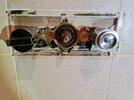Hi all, my mum has the same crosswater thermostatic valve that I have. Mine is mains water pressure, hers is on a gravity fed system. Over time, the pressure on hers has been dropping off (substantially).
It looks like the following (but with slightly different tap heads).
 www.crosswater.co.uk
www.crosswater.co.uk
I isolated the supplies and removed the face plate.
I undid the "nut" that holds the thermostatic valve in place, and then realised that I don't know how to remove the valve....

I guess that it pulls forward, but didn't want to force it.
The two screws either side of the thermostatic valve, what to they do? I removed one (screw only), then put it back. It now weeps very slightly. I guess that they adjust the flow to the twisty valve next to them. After removing and replacing the first screw I twisted the one on the other side, by less than a quarter turn, that one now weeps too.
On the balance of probability, if I drop the thermostatic valve in a bucket of limescale remover, is it likely to restore the previous pressure? BTW, the pressure was never brilliant. I suspect that she needs a pump- but that is another post.
Tnx.
It looks like the following (but with slightly different tap heads).
Kai Lever 3 Outlet 3 Handle Concealed Thermostatic Shower Valve Landscape (Kai Lever 3 Outlet 3 Handle Concealed Thermostatic Shower Valve Landscape ) | SKU | Crosswater Bathrooms
Kai Lever 3 Outlet 3 Handle Concealed Thermostatic Shower Valve Landscape (Kai Lever 3 Outlet 3 Handle Concealed Thermostatic Shower Valve Landscape ) | SKU | Crosswater Bathrooms
I isolated the supplies and removed the face plate.
I undid the "nut" that holds the thermostatic valve in place, and then realised that I don't know how to remove the valve....

I guess that it pulls forward, but didn't want to force it.
The two screws either side of the thermostatic valve, what to they do? I removed one (screw only), then put it back. It now weeps very slightly. I guess that they adjust the flow to the twisty valve next to them. After removing and replacing the first screw I twisted the one on the other side, by less than a quarter turn, that one now weeps too.
On the balance of probability, if I drop the thermostatic valve in a bucket of limescale remover, is it likely to restore the previous pressure? BTW, the pressure was never brilliant. I suspect that she needs a pump- but that is another post.
Tnx.

